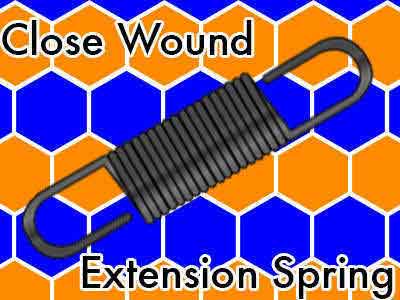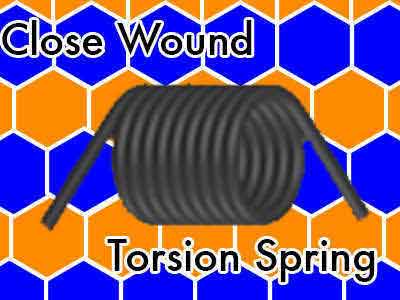Close Wound Coil Springs
Definition:
A coil spring which is manufactured by leaving out the pitch or space in between the coils thus making all of its coils touch.
Close wound coil springs are those which don’t have any pitch in between the coils. Close wound coil springs off the machine are like extension springs without hooks. This example also applies to torsional coil springs and other more customized close wound coil spring designs.
Close Wound Extension Springs
Close wound extension springs are used to exert a linear force when being pulled. The coils of this spring type are kept close wound by initial tension. You are able to measure a close wound extension spring’s initial tension by extending it to the point where the spring’s coils are separated only enough so that you are able to see light in between them. This measurement is completely separate from the calculated spring rate and must be added additionally to the working load. For example, if your spring has a rate of 20 pounds of force per inch and an initial tension of 5 pounds of force, it will take the spring 25 pounds of force to extend 1 inch of distance traveled and 45 pounds of force to travel two inches. The initial tension is not constant or accumulative like the spring rate is; you will only need to add it once. Close wound extension springs are able to be pulled apart from the hooks on each end. The hooks are made by adding an extra coil and bending this coil outwards as to form the desired hook.
Close Wound Torsion Springs
Close wound torsion springs are used to exert a rotational force when a torque is applied on one or both of its legs. These close wound coil springs have legs coming off of the ends which are wires that are kept straight after finishing the coil winding. The legs allow for you to place torque on the spring so that it may wind in the direction you required. The direction of wind is determined when you look at a spring down through its barrel and the back leg (the leg furthest away from you) is horizontal and at the top of the spring’s OD. The wind direction is determined based on which direction that back leg is pointing to.
Close Wound Ends
Close wound ends are not a type of spring, they are actually a type of ends for an open wound spring. Open wound springs include compression springs, cone springs, and barrel springs. Close wound ends provide stability to open wound springs. Some times these ends may be ground and other times, to provide more stability, they may have more than one close wound coil on the ends to provide more stability.






 Español
Español